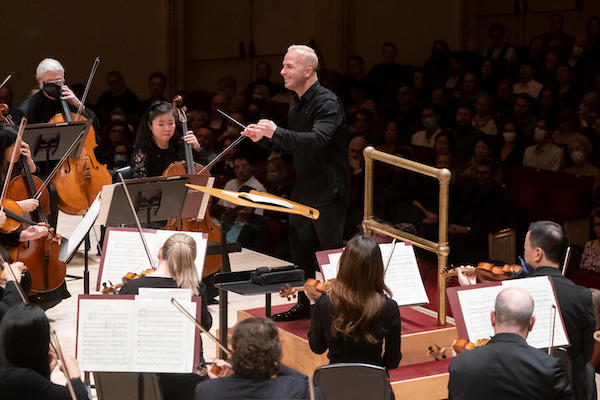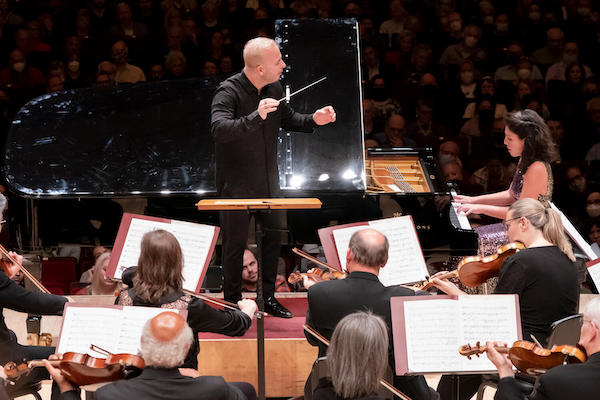Philadelphia Orchestra mixes it up at Carnegie with enjoyable results

The Philadelphia Orchestra and conductor Yannick Nézet-Séguin returned to Carnegie Hall Friday night with the kind of non-thematic, mishmash program that long entertained audiences in the 19th century but has since mostly disappeared from the serious concert stage.
Not that the music—Ravel, Florence Price, and Clara Schumann—wasn’t serious, but the combination and sequence of the music was arranged, not according to conventional wisdom, but to provide maximum enjoyment.
The de facto concert structure of overture, concerto, and symphony has been hidebound for so long that any alternative piques interest. Friday night Philadelphia did things backward and sort of sideways: opening with Ravels Le tombeau de Couperin, followed by Price’s Symphony No. 3; then after intermission playing Schumann’s Piano Concerto in A minor, played by Beatrice Rana, and finishing with more Ravel, the Bolero.
Nézet-Séguin’s direction often leans toward fast, loud, and blunt. That made Ravel an inspired choice. Le Tombeau is bright, but often quiet and with a spotlight on the woodwinds. The playing can’t be too loud and must be clear, and this performance was very fine, the woodwinds showing off a great blend of colors and timbres. The tempos and overall flow of the music seemed ideal, a combination of relaxation and velocity, like water water heading down a smooth, gentle slope, the atmosphere sunny with a slight, pleasant haze.
It was the brass that came to the fore in the Price symphony, playing with a full sound with a little bit of crunch in the opening, and with real heft throughout. The orchestra has already done a real service by producing a definitive recording of all of Price’s symphonies, and it was good to hear them play this one. Price’s symphonies follow after Dvořák, and poignantly, and often thrillingly, realize his argument that American classical music should look to the music of black Americans as an inspirational national source.
Price’s Symphony No. 3 is a model 20th century American work, mixing vernacular ideas and modernist harmonies, with the combination of grace and gritty strength that is part of the American sound. The music moves between tenderness and power, light and dark, and the orchestra’s playing was terrific, full of focus and energy. Again, Nézet-Séguin marked off a fine pace and stuck with it, never pushing the excitement and setting out the internal contrasts within each movement.
Clara Schumann’s Piano Concerto is a work from when she was still Clara Wieck, the prodigy, written in her mid-teens, It’s a fascinating piece both in its weaknesses and strengths. In the standard three movements, fast-slow-fast, it doesn’t really have a cadenza, trading that for a second movement Romanze that is close to a piano solo. It’s also seriously lopsided, with a finale that’s too long in proportion to the previous music. The orchestral writing is nondescript.
And yet the piano part is superb, with deep musicality and great emotional sophistication—it’s the kind of music where one follows each line for how good it sounds on the piano, then is knocked sideways for how the mood changes drastically, and returns to the original feeling,, within the space of two or three notes.

One could not imagine hearing this music better than Rana played it. She produced a big, rounded sound, and took care to articulate every phrase, letting the elegance and substance of the music speak, no matter how fast or dense. The Romanze was gorgeous and deeply compelling, with moving emotions when principal cellist Hai-Ye Ni joined in with her accompanying line.
There’s nothing like Bolero for a happy ending to a concert, and the orchestra delivered. This was technically expert, and the long ramp up from whispery climax to thundering conclusion was fantastically well done. All the solos were as fine as one would expect from such a great orchestra, especially bassoonist Daniel Matsukawa’s ultra-stylish turn. When the whole string section took the spotlight, the sound was fantastic, the musicians unleashed and playing with huge spirit—it was beautiful to see the bass section rocking dramatically back and forth with each bow stroke. Showpiece, technical marvel, and a ball of fun all in one, it was a hell of a way to end the evening.
The Philadelphia Orchestra and conductor Yannick Nézet-Séguin perform Xi Wang, Mozart’s Clarinet Concerto with Ricardo Morales, and Mahler’s Symphony No. 4 with soloist Pretty Yende, 8 p.m., December 13. carnegiehall.org
Posted Oct 30, 2022 at 8:47 pm by Hdhouse
What one expects, and is grateful for, from this most listenable of orchestras.